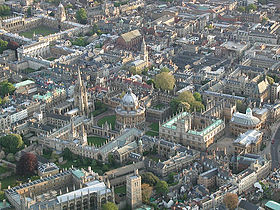
The history of Oxford in England dates back to its original settlement in the Saxon period. Originally of strategic significance due to its controlling location on the upper reaches of the River Thames at its junction with the River Cherwell. The town grew in national importance during the Norman period. The University of Oxford was established in the 12th-century and would eventually dominate the activity within the town, this also resulted in several town and gown conflicts.[1] The city was besieged during The Anarchy in 1142 and Oxford Castle was attacked during the Barons War in the early 13th century.[2] Oxford was greatly affected during the English Reformation, brought on by Henry VIII in his dissolution of the monasteries. The town also played an important role in the English Civil War, where it experienced another siege when it housed the court of Charles I.[3]
Later in the 19th and 20th century, the town grew and underwent an industrial boom where major printing and car-manufacturing industries began establishing in the city. These industries later declined in the 1970s and 1980s, leaving behind a city that is now well known for its education and tourist industry.[4]
- ^ Morris, Jan (2001). Oxford. Oxford: Oxford University Press. ISBN 978-0-19-280136-4.
- ^ Hassal, T. G. (1976). "Excavations at Oxford Castle: 1965-1973" (PDF).
- ^ Keeble, N. H. (2002). The Restoration: England in the 1660s. Wiley-Blackwell.
- ^ Curl, James Stevens (1977). The Erosion of Oxford. Oxford Illustrated Press Ltd. ISBN 0-902280-40-6.
